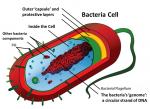|
This section contains 184 words (approx. 1 page at 300 words per page) |
The eubacteria are the largest and most diverse taxonomic group of bacteria. Some regard this as an artificial assemblage, merely a group of convenience rather than a natural grouping. The eubacteria are all easily stained, rod-shaped or spherical bacteria. They are generally unicellular, but a small number of multicellular forms do occur. They can be motile or non- motile and the motile forms are frequently characterised by the presence of numerous flagellae. Many of the ecologically important bacteria responsible for the fixation of nitrogen, such as Azotobacter and Rhizobium, are found in this group.
The cell walls of all of these species are relatively thick and unchanging, thus shape is generally constant within groups found in the eubacteria. Thick cell walls are an evolutionary adaptation that allows survival in extreme situations where thinner walled bacteria would dry out. Some of the bacteria are gram positive whilst others are gram negative. One commonality that can be found within the group is that they all reproduce by transverse binary fission, although not all bacteria that reproduce in this manner are members of this group.
|
This section contains 184 words (approx. 1 page at 300 words per page) |


